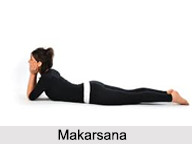 Makarasana is also known as the `crocodile pose`. This asana is a type of cultural asana. `Makara` means `Crocodile` and while doing this Asana the body resembles the shape of the `crocodile`, hence it is known as Makarasana. The general posture of this asana shows the body to be lying, the chest should touch the ground and both the legs should stretch out. The person holds the head with both the arms. Makarasana increases the heat of the body.
Makarasana is also known as the `crocodile pose`. This asana is a type of cultural asana. `Makara` means `Crocodile` and while doing this Asana the body resembles the shape of the `crocodile`, hence it is known as Makarasana. The general posture of this asana shows the body to be lying, the chest should touch the ground and both the legs should stretch out. The person holds the head with both the arms. Makarasana increases the heat of the body.
Myth of Makarsana
Commonly known as crocodile, the word Makara has other various translations like a sea-creature in the form of a shark or dolphin or it might even be a mythical beast. In the Hindu mythology, the makara is known to be the animal vehicle or vahana of the sea God Varuna, and of the river Goddess Ganga.
A different myth in the Hindu epic Ramayana tells how Lord Hanuman, seeking to drink from a lake, was once seized, pulled under, and swallowed by a crocodile. Hanuman changed his shape to become so large that the crocodile burst; leaving a beautiful apsara nymph named Dhyanamalini who revealed that she had been cursed to become the monster
Practice of Makarasana
The person should lie on their stomach flat on the ground; the hands should remain by the side of the thighs.
One should slowly spread out both the legs. The toes should remain out and heels inward.
The person should slowly fold the left hand at elbow bringing it from below the armpit and place it in the right shoulder. One has to fold the right hand at the elbow and place it on the left shoulder.
The person places the head on the triangle made by both the elbows.
There can be few variations while practicing Makarasana. The person can bring either hand on the shoulder from below the armpit, if it is difficult to place one elbow on the other, one can place both elbows slightly apart. Head should essentially remain inside elbow. If it is difficult to rest the head, one may keep chin between the elbows.
Effects and precautions for Makarasana
Makarasana has many therapeutic benefits. This asana is beneficial in Asthma. Makarsana also helps in a balanced functioning of the abdominal organs and improves the blood circulation in the body. This asana also helps in getting rid of stress, anxiety, tension and fatigue. It is effective in treating respiratory arrhythmia. Abdominal muscles get an automatic massage while practicing Makarasana. Those having heart problems, obesity, gas or high blood pressure should not practice Makarasana.




















